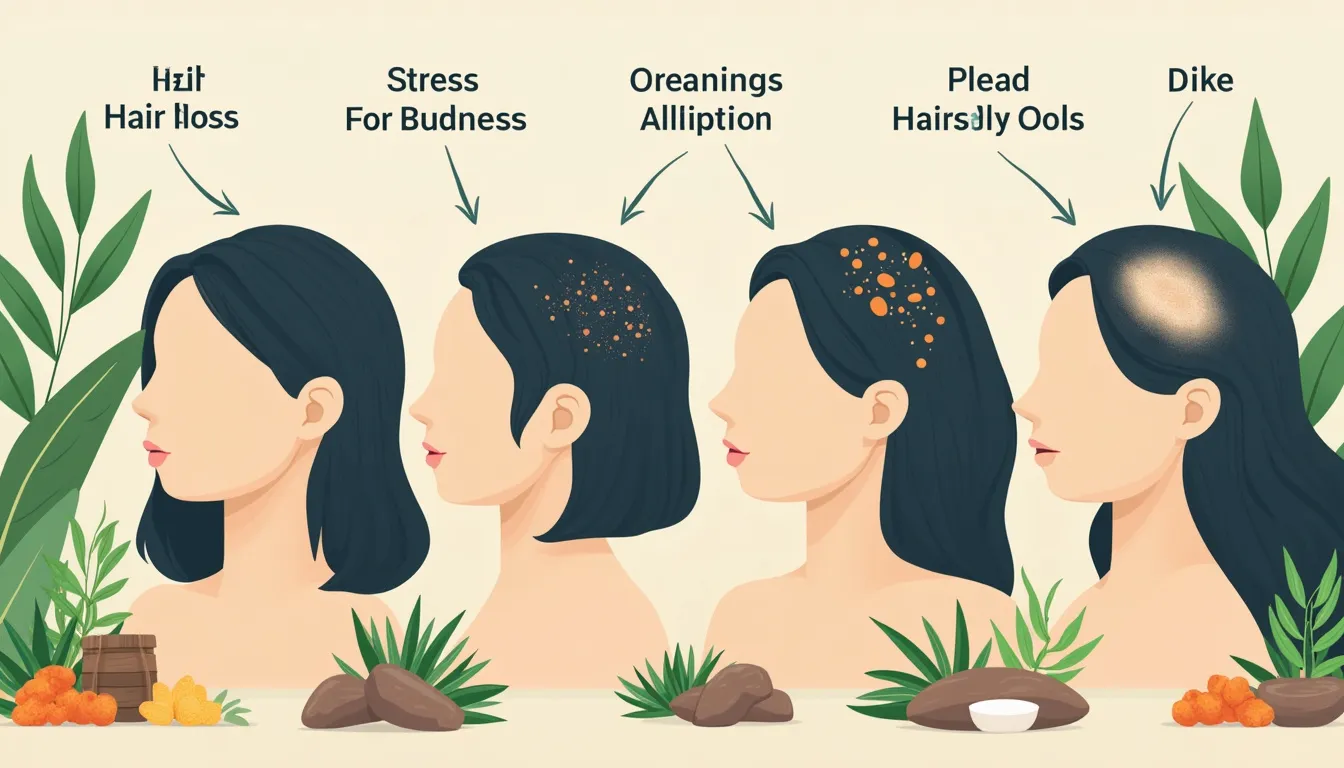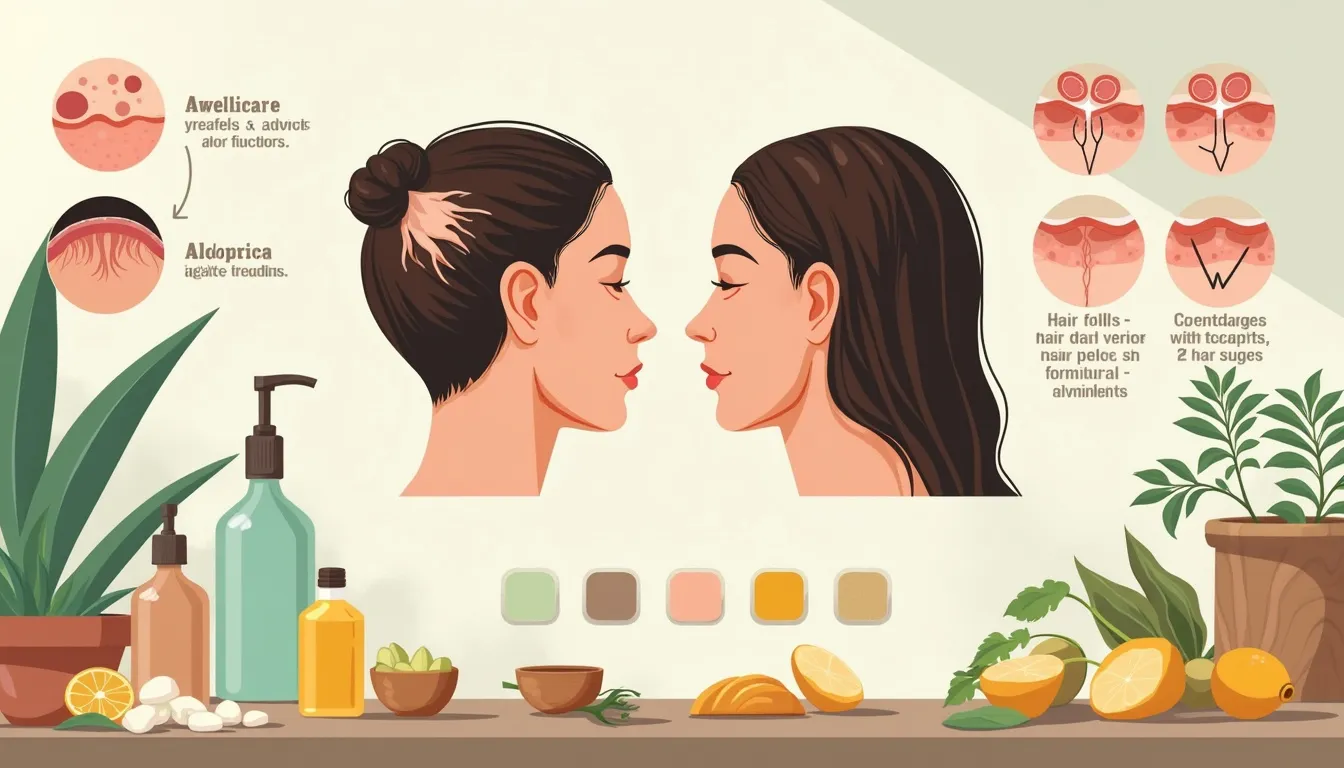Have you ever found yourself staring at your hairbrush, shocked by the amount of hair left behind after a simple grooming session? Or perhaps you’ve noticed thinning patches on your scalp that weren’t there before? If so, you’re not alone. Millions of people worldwide grapple with hair loss, and one of the most common culprits is alopecia. This perplexing condition affects individuals of all ages, genders, and backgrounds, often leaving them feeling vulnerable and searching for answers.
Alopecia, derived from the Greek word alōpekía meaning fox mange, is more than just a fancy term for hair loss. It encompasses a range of conditions that can lead to partial or complete baldness, impacting not only one’s appearance but also their self-esteem and quality of life. From the gradual thinning associated with androgenetic alopecia to the sudden, patchy hair loss of alopecia areata, this condition manifests in various forms, each with its unique challenges and treatment approaches.
In this comprehensive guide, we’ll delve into the world of alopecia, dispelling common myths and shedding light on its causes, types, and available treatment options. Whether you’re personally affected by hair loss or simply curious about this widespread phenomenon, understanding alopecia is the first step towards empowerment and effective management. So, let’s embark on this hair-raising journey together and uncover the truth behind those falling strands.
What is Alopecia?
Definition and Overview
Alopecia is a general term that refers to hair loss from any part of the body, but it’s most commonly used to describe hair loss from the scalp. The word alopecia comes from the Greek word alōpekía, meaning fox mange, which refers to hair loss in foxes. While this might seem like an odd connection, it highlights the long history of human awareness of this condition.
At its core, alopecia is a disorder that disrupts the normal cycle of hair growth. In a healthy hair growth cycle, each hair follicle goes through three phases:
- Anagen (growth phase)
- Catagen (transitional phase)
- Telogen (resting phase)
When alopecia occurs, this cycle is disturbed, leading to excessive hair loss or the inability to produce new hair. The severity of alopecia can vary significantly, ranging from small, barely noticeable patches to complete loss of hair on the scalp (alopecia totalis) or even the entire body (alopecia universalis).
Prevalence and Impact on Individuals
Alopecia is far more common than many people realize. According to the National Alopecia Areata Foundation, approximately 147 million people worldwide experience some form of alopecia. In the United States alone, over 6.8 million people are estimated to have or will develop alopecia areata at some point in their lives.
The impact of alopecia on individuals can be profound and multifaceted. While it’s not a life-threatening condition, the psychological and emotional toll can be significant. Many people with alopecia report feelings of:
- Low self-esteem
- Anxiety
- Depression
- Social isolation
These emotional challenges often stem from societal pressures and beauty standards that place a high value on hair. For many, hair is closely tied to identity, attractiveness, and even professionalism. Losing it can feel like losing a part of oneself.
Moreover, alopecia can affect people of all ages, genders, and ethnicities. While certain types of alopecia are more common in specific demographics (for example, androgenetic alopecia is more prevalent in men), no one is immune to the condition. This universality adds to its impact, as it can strike unexpectedly at any stage of life.
Common Misconceptions about Alopecia
Despite its prevalence, alopecia is often misunderstood. Let’s debunk some common myths:
- Myth: Alopecia is caused by stress. While stress can exacerbate certain types of alopecia, it’s rarely the sole cause. Most forms of alopecia have complex underlying mechanisms involving genetics, immune system function, or hormonal changes.
- Myth: Alopecia only affects older men. While male pattern baldness (a type of alopecia) is common in older men, alopecia can affect anyone regardless of age or gender. For instance, alopecia areata often begins in childhood or early adulthood.
- Myth: Alopecia is contagious. This is entirely false. Alopecia is not an infectious disease and cannot be spread through contact.
- Myth: Wearing hats causes alopecia. There’s no scientific evidence to support this claim. However, very tight hairstyles that pull on the hair can lead to a type of alopecia called traction alopecia.
- Myth: There’s nothing you can do about alopecia. While it’s true that some forms of alopecia have no cure, many treatment options can help manage the condition or promote hair regrowth. From medications to lifestyle changes, there are various strategies to explore.
Understanding these misconceptions is crucial for fostering empathy and support for those experiencing alopecia. It also highlights the importance of seeking accurate information and professional medical advice when dealing with hair loss.
As we delve deeper into the world of alopecia, it’s essential to approach the topic with sensitivity and openness. Whether you’re experiencing hair loss yourself or supporting someone who is, remember that alopecia is a medical condition, not a personal failing. With the right information and support, it’s possible to navigate the challenges of alopecia and maintain a positive self-image.
If you’re concerned about hair loss and want to take proactive steps, consider exploring hair loss prevention programs. One such option is the Fortify program, which offers strategies to help combat hair loss.

Types of Alopecia and Their Causes
Alopecia, a term that encompasses various forms of hair loss, can manifest in different ways depending on its underlying cause. Understanding the various types of alopecia and their origins is crucial for proper diagnosis and treatment. Let’s explore the most common types of alopecia and delve into their causes.
Androgenetic Alopecia (Male and Female Pattern Baldness)
Androgenetic alopecia, commonly known as male or female pattern baldness, is the most prevalent form of hair loss. This type of alopecia affects millions of people worldwide and is characterized by a gradual thinning of hair, typically following a specific pattern.
In men, hair loss often begins at the temples and crown, forming the classic M shape. Women, on the other hand, usually experience a general thinning across the scalp, particularly noticeable at the part line.
The primary cause of androgenetic alopecia is a combination of genetic predisposition and hormonal factors. Dihydrotestosterone (DHT), a hormone derived from testosterone, plays a significant role in this type of hair loss. In genetically susceptible individuals, DHT can cause hair follicles to shrink over time, leading to progressively thinner and shorter hair.
Alopecia Areata
Alopecia areata is an autoimmune condition that causes hair loss in patches. These patches are typically smooth, round, and about the size of a coin. In some cases, alopecia areata can progress to total scalp hair loss (alopecia totalis) or complete body hair loss (alopecia universalis).
The exact cause of alopecia areata remains unknown, but it’s believed to be the result of the immune system mistakenly attacking hair follicles. Factors that may trigger or exacerbate this condition include:
- Stress
- Viral infections
- Hormonal changes
- Genetics (family history of autoimmune disorders)
While alopecia areata can be distressing, it’s important to note that the hair follicles remain alive, and hair regrowth is possible, even after long periods of hair loss.
Telogen Effluvium
Telogen effluvium is a temporary form of hair loss characterized by excessive shedding of hair. This type of alopecia occurs when a large number of hair follicles enter the telogen (resting) phase of the hair growth cycle simultaneously, leading to increased hair fall.
Several factors can trigger telogen effluvium, including:
- Severe stress or shock
- Major surgery or illness
- Hormonal changes (e.g., childbirth, menopause)
- Rapid weight loss or crash dieting
- Nutritional deficiencies
- Certain medications
Telogen effluvium typically resolves on its own once the underlying cause is addressed. However, in some cases, it can become chronic, lasting for several months or even years.
Scarring Alopecia
Scarring alopecia, also known as cicatricial alopecia, is a group of disorders that destroy hair follicles, replacing them with scar tissue. This type of alopecia can be particularly distressing as it often leads to permanent hair loss in affected areas.
The causes of scarring alopecia vary and can include:
- Autoimmune disorders (e.g., lupus erythematosus, lichen planopilaris)
- Infections (bacterial or fungal)
- Physical trauma (burns, radiation)
- Certain skin conditions (e.g., folliculitis decalvans)
Early diagnosis and treatment are crucial in managing scarring alopecia to prevent further hair loss and potential scarring.
Traction Alopecia
Traction alopecia is a form of hair loss caused by prolonged tension on the hair follicles. This type of alopecia is often seen in individuals who frequently wear tight hairstyles that pull on the hair, such as:
- Tight ponytails or buns
- Braids or cornrows
- Hair extensions or weaves
- Dreadlocks
The constant pulling of hair can damage the follicles, leading to gradual hair thinning and eventual hair loss, particularly around the hairline and temples. If caught early, traction alopecia can be reversed by changing hairstyling practices. However, prolonged tension can result in permanent hair loss due to scarring of the follicles.
Understanding the various types of alopecia and their causes is the first step in addressing hair loss concerns. If you’re experiencing unexpected hair loss, it’s essential to consult with a dermatologist or trichologist for an accurate diagnosis and appropriate treatment plan. Remember, early intervention can often lead to better outcomes in managing alopecia.
For those looking to take proactive steps in maintaining hair health and preventing hair loss, consider exploring Hair Security’s Fortify program. This comprehensive approach combines cutting-edge research with practical solutions to help you maintain a healthy, full head of hair.

Treatment Options and Management Strategies
When it comes to managing alopecia, there’s no one-size-fits-all solution. The treatment approach depends on the type of alopecia, its severity, and individual patient factors. Let’s dive into the various options available for those dealing with hair loss.
A. Medical Treatments (Topical and Oral Medications)
Medical treatments are often the first line of defense against alopecia. These can be broadly categorized into topical and oral medications:
Topical Medications:
- Minoxidil: Available over-the-counter, minoxidil is FDA-approved for both men and women. It’s believed to work by increasing blood flow to the scalp and prolonging the growth phase of hair follicles. While it doesn’t cure alopecia, it can slow hair loss and promote regrowth in some cases.
- Corticosteroids: These anti-inflammatory drugs can be applied directly to the scalp for conditions like alopecia areata. They work by suppressing the immune response that attacks hair follicles.
- Anthralin: This medication can help stimulate hair growth in people with alopecia areata by creating mild skin irritation that may prompt hair regrowth.
Oral Medications:
- Finasteride: This prescription medication is FDA-approved for men with male pattern baldness. It works by blocking the conversion of testosterone to dihydrotestosterone (DHT), which is responsible for hair follicle shrinkage.
- Spironolactone: While primarily used as a blood pressure medication, it can also be prescribed off-label for women with androgenetic alopecia due to its anti-androgen properties.
- Immunosuppressants: For severe cases of alopecia areata, drugs like methotrexate or cyclosporine may be prescribed to suppress the immune system’s attack on hair follicles.
It’s crucial to consult with a dermatologist or trichologist before starting any medication, as they can have side effects and may not be suitable for everyone.
B. Hair Restoration Procedures
For those seeking more permanent solutions, several hair restoration procedures are available:
- Hair Transplantation: This surgical procedure involves moving hair from areas of thick growth to balding areas. Techniques like Follicular Unit Transplantation (FUT) and Follicular Unit Extraction (FUE) have advanced significantly, producing natural-looking results.
- Scalp Micropigmentation: This cosmetic procedure involves tattooing pigment into the scalp to create the appearance of a fuller head of hair or a closely-shaved look.
- Platelet-Rich Plasma (PRP) Therapy: This innovative treatment uses the patient’s own blood plasma, rich in growth factors, to stimulate hair follicles and promote regrowth.
- Low-Level Laser Therapy (LLLT): This non-invasive treatment uses red light therapy to stimulate hair growth and is available in clinical settings or as at-home devices.
While these procedures can be effective, they often come with a hefty price tag and may require multiple sessions for optimal results.
C. Lifestyle Changes and Natural Remedies
Sometimes, simple lifestyle modifications and natural remedies can help manage alopecia:
- Balanced Diet: Ensuring adequate intake of proteins, vitamins (especially B-vitamins and vitamin D), and minerals like iron and zinc can support healthy hair growth.
- Stress Management: Chronic stress can exacerbate hair loss. Techniques like meditation, yoga, or regular exercise can help manage stress levels.
- Gentle Hair Care: Avoiding harsh chemical treatments and heat styling, and using gentle, sulfate-free hair products can prevent further damage to fragile hair.
- Natural Oils: Some people find success with natural remedies like rosemary oil, peppermint oil, or castor oil, which may stimulate hair growth when massaged into the scalp.
- Scalp Massage: Regular scalp massages can increase blood flow to hair follicles, potentially promoting hair growth.
While these natural approaches are generally safe, it’s important to remember that their effectiveness can vary greatly among individuals.
D. Coping Strategies and Support Resources
Dealing with alopecia isn’t just about treating the physical symptoms; it’s also about managing the emotional impact:
- Support Groups: Organizations like the National Alopecia Areata Foundation offer support groups and resources for individuals with alopecia.
- Counseling: Talking to a mental health professional can help in dealing with the psychological effects of hair loss.
- Hair Accessories: Wigs, hairpieces, scarves, and hats can help boost confidence and provide a sense of control over one’s appearance.
- Education and Awareness: Learning about alopecia and educating others can help reduce stigma and increase understanding.
Remember, while hair loss can be challenging, it doesn’t define a person. Many individuals with alopecia lead fulfilling lives and find ways to embrace their unique appearance.
For those looking for additional support in their hair loss journey, programs like Hair Security’s Fortify can provide valuable resources and strategies to help combat hair loss.
In conclusion, while alopecia can be a distressing condition, numerous treatment options and management strategies are available. From medical treatments to lifestyle changes, and from hair restoration procedures to support resources, individuals with alopecia have more choices than ever before. The key is to work closely with healthcare professionals to find the most suitable approach for each unique situation.
In conclusion, alopecia is a complex and multifaceted condition that affects millions of people worldwide. As we’ve explored in this article, there are various types of alopecia, each with its own unique causes and characteristics. From androgenetic alopecia, the most common form, to less frequent types like alopecia areata and scarring alopecia, understanding the specific nature of hair loss is crucial for effective treatment and management.
While hair loss can be distressing, it’s important to remember that numerous treatment options and management strategies are available. From medical interventions like topical and oral medications to hair restoration procedures, individuals with alopecia have more choices than ever before. Additionally, lifestyle changes, natural remedies, and coping strategies can play a significant role in managing the condition and improving overall well-being.
It’s crucial to consult with a healthcare professional or dermatologist to determine the best course of action for your specific case of alopecia. They can provide personalized advice and treatment plans tailored to your needs and circumstances. Remember, you’re not alone in this journey – support groups and resources are available to help you navigate the challenges of living with alopecia.
As research continues to advance, new treatments and understanding of alopecia are emerging. Stay informed about the latest developments and maintain open communication with your healthcare provider to ensure you’re receiving the most up-to-date and effective care.
Ultimately, while alopecia can be challenging, it doesn’t define you. With the right approach, support, and treatment, many individuals with alopecia lead fulfilling lives and find ways to embrace their unique appearance. Whether you choose to seek treatment, explore alternative hair solutions, or confidently rock your natural look, remember that your worth extends far beyond your hair.
If you’re looking for additional support and resources to help manage hair loss, consider exploring programs like the one offered at hairsecurity.net/fortify. This comprehensive approach may provide valuable tools and strategies to help you on your hair health journey.
By staying informed, seeking support, and exploring your options, you can take control of your alopecia and move forward with confidence and resilience.
